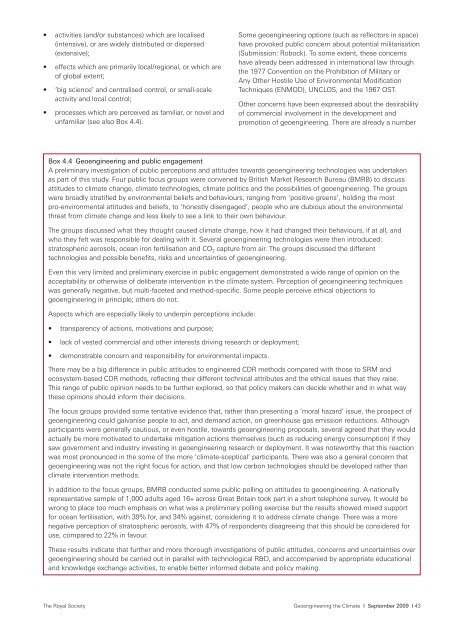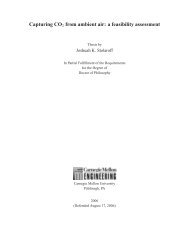Royal Society - David Keith
Royal Society - David Keith
Royal Society - David Keith
You also want an ePaper? Increase the reach of your titles
YUMPU automatically turns print PDFs into web optimized ePapers that Google loves.
• activities (and/or substances) which are localised<br />
(intensive), or are widely distributed or dispersed<br />
(extensive);<br />
• effects which are primarily local/regional, or which are<br />
of global extent;<br />
• ‘big science’ and centralised control, or small-scale<br />
activity and local control;<br />
• processes which are perceived as familiar, or novel and<br />
unfamiliar (see also Box 4.4).<br />
Some geoengineering options (such as reflectors in space)<br />
have provoked public concern about potential militarisation<br />
(Submission: Robock). To some extent, these concerns<br />
have already been addressed in international law through<br />
the 1977 Convention on the Prohibition of Military or<br />
Any Other Hostile Use of Environmental Modification<br />
Techniques (ENMOD), UNCLOS, and the 1967 OST.<br />
Other concerns have been expressed about the desirability<br />
of commercial involvement in the development and<br />
promotion of geoengineering. There are already a number<br />
Box 4.4 Geoengineering and public engagement<br />
A preliminary investigation of public perceptions and attitudes towards geoengineering technologies was undertaken<br />
as part of this study. Four public focus groups were convened by British Market Research Bureau (BMRB) to discuss<br />
attitudes to climate change, climate technologies, climate politics and the possibilities of geoengineering. The groups<br />
were broadly stratified by environmental beliefs and behaviours, ranging from ‘positive greens’, holding the most<br />
pro-environmental attitudes and beliefs, to ‘honestly disengaged’, people who are dubious about the environmental<br />
threat from climate change and less likely to see a link to their own behaviour.<br />
The groups discussed what they thought caused climate change, how it had changed their behaviours, if at all, and<br />
who they felt was responsible for dealing with it. Several geoengineering technologies were then introduced:<br />
stratospheric aerosols, ocean iron fertilisation and CO 2 capture from air. The groups discussed the different<br />
technologies and possible benefits, risks and uncertainties of geoengineering.<br />
Even this very limited and preliminary exercise in public engagement demonstrated a wide range of opinion on the<br />
acceptability or otherwise of deliberate intervention in the climate system. Perception of geoengineering techniques<br />
was generally negative, but multi-faceted and method-specific. Some people perceive ethical objections to<br />
geoengineering in principle; others do not.<br />
Aspects which are especially likely to underpin perceptions include:<br />
• transparency of actions, motivations and purpose;<br />
• lack of vested commercial and other interests driving research or deployment;<br />
• demonstrable concern and responsibility for environmental impacts.<br />
There may be a big difference in public attitudes to engineered CDR methods compared with those to SRM and<br />
ecosystem-based CDR methods, reflecting their different technical attributes and the ethical issues that they raise.<br />
This range of public opinion needs to be further explored, so that policy makers can decide whether and in what way<br />
these opinions should inform their decisions.<br />
The focus groups provided some tentative evidence that, rather than presenting a ‘moral hazard’ issue, the prospect of<br />
geoengineering could galvanise people to act, and demand action, on greenhouse gas emission reductions. Although<br />
participants were generally cautious, or even hostile, towards geoengineering proposals, several agreed that they would<br />
actually be more motivated to undertake mitigation actions themselves (such as reducing energy consumption) if they<br />
saw government and industry investing in geoengineering research or deployment. It was noteworthy that this reaction<br />
was most pronounced in the some of the more ‘climate-sceptical’ participants. There was also a general concern that<br />
geoengineering was not the right focus for action, and that low carbon technologies should be developed rather than<br />
climate intervention methods.<br />
In addition to the focus groups, BMRB conducted some public polling on attitudes to geoengineering. A nationally<br />
representative sample of 1,000 adults aged 16+ across Great Britain took part in a short telephone survey. It would be<br />
wrong to place too much emphasis on what was a preliminary polling exercise but the results showed mixed support<br />
for ocean fertilisation, with 39% for, and 34% against, considering it to address climate change. There was a more<br />
negative perception of stratospheric aerosols, with 47% of respondents disagreeing that this should be considered for<br />
use, compared to 22% in favour.<br />
These results indicate that further and more thorough investigations of public attitudes, concerns and uncertainties over<br />
geoengineering should be carried out in parallel with technological R&D, and accompanied by appropriate educational<br />
and knowledge exchange activities, to enable better informed debate and policy making.<br />
The <strong>Royal</strong> <strong>Society</strong><br />
Geoengineering the Climate I September 2009 I 43








